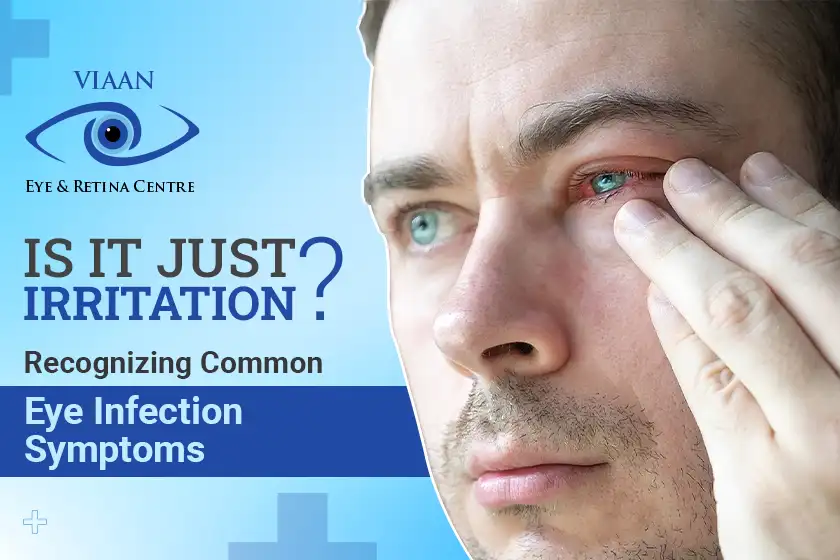One of the most common complaints we always hear from patients is eye irritation. Whether it’s due to pollution, long hours in front of a screen, or simple fatigue, eye discomfort is something many of us brush off. But when should we start to worry that this irritation is more than just tired eyes? Eye infections are often overlooked, yet they can have serious consequences if not treated promptly. Let’s walk through the common eye infection symptoms when to seek help, and some statistics from India to highlight just how prevalent these issues are.
What Is an Eye Infection?
Eye infection symptoms occur when harmful microorganisms—like bacteria, viruses, or fungi—invade the eye or surrounding tissues. These infections can affect different parts of the eye, including the cornea, conjunctiva, or eyelids.
In India, eye infections are particularly prevalent, with conjunctivitis (often called “pink eye”) being one of the most common. The climate, air pollution levels, and dust in urban areas can significantly contribute to the rising cases of eye infections. According to a study by the All India Ophthalmological Society (AIOS), conjunctivitis affects nearly 20% of the population annually, particularly during monsoon seasons when viral infections are more rampant.
Common Eye Infection Symptoms
As someone who’s seen a variety of eye infection symptoms over the years, I can tell you that the symptoms can be subtle or overwhelming, depending on the type of infection. Here are some common signs to watch out for:
1. Redness
A red eye is often a signal of inflammation, which may be due to infection. If the redness persists beyond a few days, especially if it’s accompanied by other symptoms, it could indicate an infection.
2. Excessive Tearing
While tearing up might be your body’s way of protecting your eyes from dryness or irritants, excessive and continuous tearing is a sign that your eye may be trying to flush out an infection.
3. Discharge
A watery or thick discharge (especially yellow or green in color) from the eye is one of the most telltale signs of an eye infection symptoms. For example, bacterial conjunctivitis typically causes a thick, sticky discharge that can crust over the eyelashes.
4. Pain and Sensitivity
Pain or a gritty feeling in the eye, often described as having “something stuck,” could be due to an infection. Increased sensitivity to light (photophobia) can also indicate that something is wrong.
5. Blurry Vision
Infections can cause swelling or inflammation in parts of the eye, leading to blurred vision. While many of us dismiss blurry vision as eye strain, it’s important to get it checked out if it doesn’t clear up after resting.
The Types of Eye Infection Symptoms
While there are many types of eye infections, here are some of the most common ones seen in India:
1. Conjunctivitis (Pink Eye)
This eye infection symptoms causes inflammation of the conjunctiva, the thin layer covering the white part of the eye. It can be viral, bacterial, or allergic. Viral conjunctivitis is especially contagious and spreads rapidly, particularly in schools or crowded areas.
In 2023 alone, conjunctivitis cases surged in various Indian states, with Delhi and Maharashtra reporting thousands of cases post-monsoon. The National Institute of Virology recorded a 30% rise in viral conjunctivitis cases compared to previous years.
2. Keratitis
This is an eye infection symptoms of the cornea, often caused by bacteria or fungi. It is commonly seen in contact lens users. Symptoms include severe pain, redness, and blurry vision. If untreated, it can lead to corneal ulcers and even blindness.
In India, where nearly 18 million people wear contact lenses, keratitis is a growing concern. A study conducted by AIIMS revealed that 25% of keratitis cases are related to poor contact lens hygiene.
3. Stye (Hordeolum)
A stye is a bacterial infection affecting the oil glands on the edge of the eyelids. It causes a painful, red bump on the eyelid. While styes are not serious, recurring ones may be a sign of chronic eyelid inflammation or underlying health issues, such as diabetes, which affects more than 77 million Indians.
When to Seek Medical Attention
While it’s tempting to brush off eye irritation and eye infection symptoms as a minor inconvenience, you should consider seeing a doctor if:
- Your symptoms persist for more than 48 hours without improvement.
- You experience severe pain, light sensitivity, or vision changes.
- There is a significant amount of discharge or crusting, especially if it’s green or yellow.
- You wear contact lenses and experience any of the above symptoms.
Ignoring these signs could lead to more severe complications. For instance, untreated keratitis can result in corneal ulcers, which could lead to vision loss. The Indian Journal of Ophthalmology noted that up to 50,000 cases of corneal blindness in India could be attributed to preventable infections each year.
Prevention Tips for Eye Infections
Prevention is always better than cure, especially when it comes to your eyes. Here’s what I usually recommend to my patients:
- Maintain Hand Hygiene: Your hands are in contact with countless surfaces and germs. Avoid touching or rubbing your eyes with unclean hands.
- Practice Contact Lens Care: If you wear contact lenses, ensure you follow proper hygiene by cleaning them with lens solution and storing them correctly. Avoid wearing them for extended periods, especially overnight.
- Use Clean Towels and Bedding: Change your towels, pillowcases, and bedsheets frequently to reduce the risk of bacterial infections, especially during the monsoon.
- Wear Protective Eyewear: If you’re in an environment where your eyes could be exposed to dust, chemicals, or bright sunlight, wearing protective eyewear can reduce the risk of infections.
- Stay Away from Contaminated Water: Swimming in pools without proper chlorine levels can expose your eyes to harmful bacteria, increasing your risk of infections.
Conclusion
Your eyes are one of the most delicate and vital organs of your body, and recognizing early signs of infection is crucial for maintaining good eye health. While some eye infection symptoms may seem like simple irritation, they could be indicators of something more serious. In India, where environmental conditions, overcrowding, and poor hygiene practices increase the risk of infections, it’s important to stay vigilant.
If you experience persistent eye symptoms, don’t hesitate to consult a Retina eye specialist. You can schedule an appointment with Viaan Eye & Retina Centre for a check-up. Early intervention can prevent complications and help you maintain your vision for years to come.



